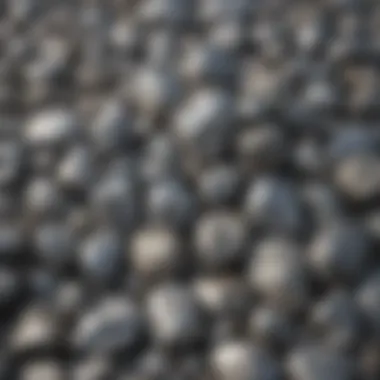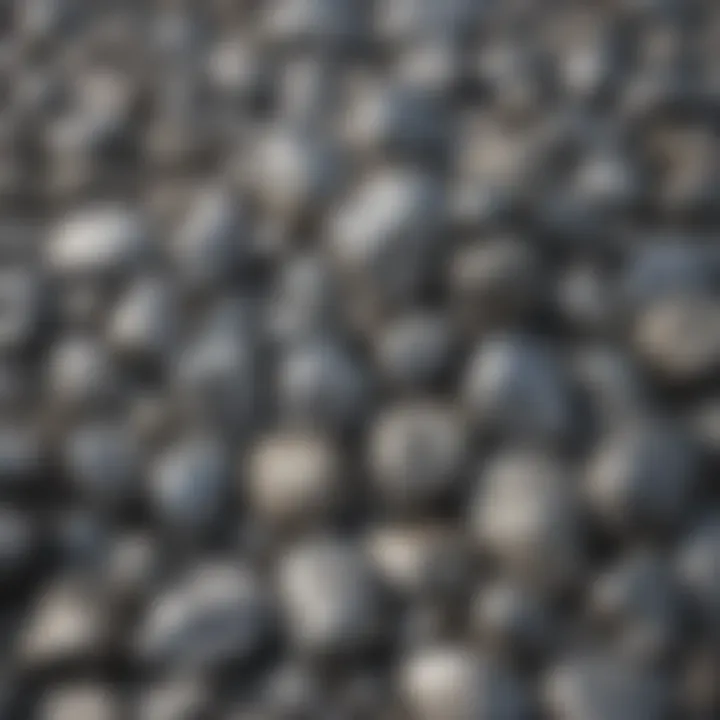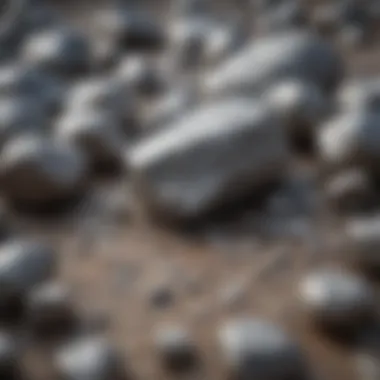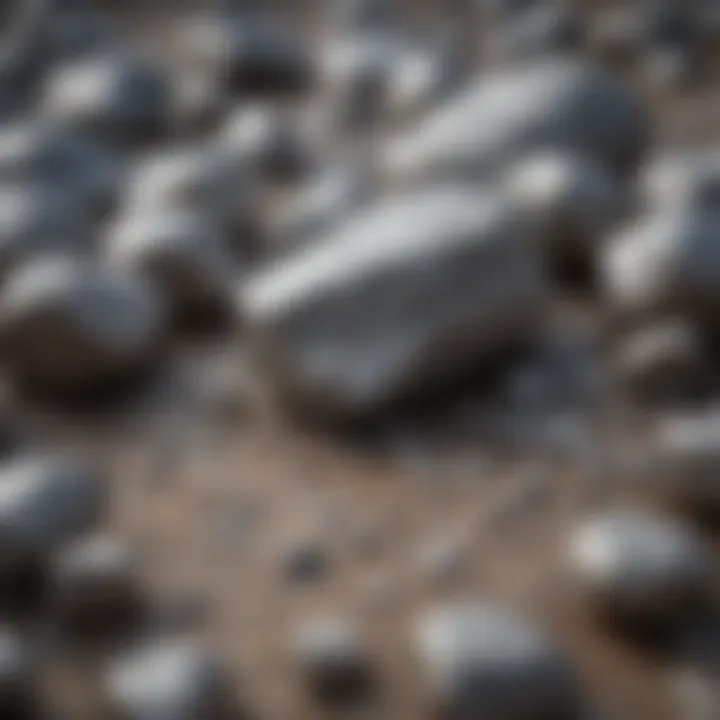Examining Rocks with Shiny Silver Flakes


Intro
When it comes to the world of rocks, there’s a certain allure that captures the eye and sparks the imagination. Among various types, those that twinkle with shiny silver flakes stand out as particularly striking specimens. The interplay of light on their glimmering surfaces can make these rocks a topic of admiration and fascination.
In this exploration, we will dissect what sets these glittering geological marvels apart, taking a hard look at their formation, significance for collectors, and practical uses in our everyday lives. By the end of this article, you’ll not only understand the scientific foundations of these remarkable rocks but also gain insight into their roles in the collecting community and how to responsibly approach their acquisition.
Featured Collectible of the Month
Overview
This month, we dive into the depths of a captivating rock known as Muscovite Mica. Jewelry makers and collectors alike have taken interest in this mineral due to its distinctive silver-like flaking. Muscovite, a member of the mica family, displays a robust sheen that can enchant anyone who lays eyes on it. Found in metamorphic rocks, this mineral reflects the secrets of the Earth’s history and formation.
Historical Significance
Historically, Muscovite Mica has held an essential place in various cultures. Native Americans, for instance, used it for ceremonial purposes and crafting tools. They believed that its reflective qualities could help in connecting with celestial figures. The charm of this rock isn't merely superficial; it symbolizes a bridge between the earthly and the spiritual.
In the 19th century, Muscovite mica was mined extensively in places like the Adirondack Mountains in New York, where artisans prided themselves on using it in windows due to its transparency and durability. Now, as collectors scour the globe for unique specimens, the historical implications of their finds deepen the sentimental value attached to each piece.
Identification Techniques
Visual Characteristics
Identifying rocks that feature shiny silver flakes requires a keen eye. Here are some telltale signs:
- Luster: A glassy shine that indicates high mineral content.
- Color Variations: Though often silver, these rocks can present shades from clear to a creamy yellow.
- Thin Layers: The physical structure of flakes gives them a layered appearance, often resembling sheets layered atop each other.
These characteristics can serve as initial indicators of Muscovite or similar minerals among collectors.
Resources for Identification
For those on the lookout for more insightful resources, the following can be invaluable:
- Wikipedia
- Britannica
- Use forums like Reddit to connect with fellow enthusiasts and seasoned collectors who can share tips and tricks for identification.
“Using the right resources and community tips can make your collection journey much more enlightening.”
By familiarizing yourself with these techniques, you can sharpen your skills in identifying shiny silver flake rocks. Whether you’re a novice or an experienced collector, understanding these aspects adds an enriching layer to your collecting journey.
Foreword to Shiny Silver Flake Rocks
Rocks featuring shiny silver flakes captivate both casual observers and dedicated collectors alike. Their shimmering surfaces often provoke curiosity and wonder, prompting inquiries into their origins and formations. Understanding these intriguing geological samples is not just about admiration; it’s about appreciating their stories, complexities, and the roles they play in the environment.
The discussion around shiny silver flake rocks isn't merely academic. These rocks encapsulate significant historical and economic narratives, embraced by various cultures through time. From their use in ornamental arts to potential applications in technology, the implications swirl with possibilities. The flake formations provide clues about ancient geological processes and terrain shifts, opening the door to richer insights regarding Earth’s history.
Defining Shiny Silver Flake Rocks
Shiny silver flake rocks are distinguished by their striking surface characteristics, predominantly marked by the presence of metallic or reflective minerals. At first glance, they seem nearly adorned, like nature’s own jewels waiting for the discerning eye. The shimmering flakes generally result from minerals such as muscovite, biotite, or even metallic silver. These rocks vary in texture, color, and mineralogy, offering a broad spectrum from which collectors can choose.
A precise definition encompasses not just the visual aspect but also geological underpinnings. The formation of these flakes can be influenced by a range of environmental factors, including pressure and temperature during metamorphic processes. In layman terms, these rocks are like little windows into the past, revealing conditions of their formation through their very structure.
Historical Context and Significance
The history of shiny silver flake rocks is rich and multifaceted. For centuries, cultures worldwide have revered these minerals—using them as raw material for tools, ornaments, and even currency. Ancient civilizations, including the Egyptians and Incas, recognized the value of silver, not just for its aesthetic appeal but also for its physical properties. Silver, being malleable and ductile, allowed artisans to work wonders that have lasted epochs.
In the modern era, shiny silver flake rocks bear significance in geology and the mineral market. They serve as indicators of past climatic changes, allowing geologists to piece together Earth’s dynamic history. As society grows increasingly mindful of sustainable practices, value assessments in terms of rarity and responsible sourcing have gained traction. Acknowledging the cultural and historical worth of these rocks enhances their appeal—transforming them from mere specimens into artifacts of human history.
"Understanding the narrative behind shiny silver flake rocks not only enriches our knowledge of geology but also connects us to ancient cultures that cherished these formations long before us."
In summary, the exploration of shiny silver flake rocks goes beyond mere collection. It invites a journey into the intricacies of natural processes, human history, and the ever-evolving dynamics of ecological stewardship. This comprehensive understanding is essential for both novice hobbyists and seasoned collectors aiming to appreciate the finer elements of their collections.
Geological Formation Processes
Understanding the geological formation processes of shiny silver flake rocks is crucial for anyone interested in these intriguing specimens. This knowledge provides insights not only into how these rocks are formed but also gives a glimpse into the historical contexts and environments in which they exist. The formation processes can illustrate the interplay of various geological forces and factors, providing a richer perspective on their composition and aesthetic qualities.
Mineral Composition Overview
At the heart of shiny silver flake rocks lies a diverse array of minerals. These minerals often include mica, biotite, and sometimes flake-like silver minerals such as argentite. Mica, in particular, plays a pivotal role; its layered structure allows for the brilliant reflections that give these rocks their characteristic shine. Collectors often marvel at the way light dances off these surfaces, and understanding their mineral composition can enhance appreciation for their beauty and complexity.
Common minerals found in these rocks include:


- Mica
- Argentite
- Biotite
- Galena
The presence and abundance of these minerals can dramatically affect the look and feel of the rock. For instance, a rock rich in mica will be distinctly reflective, while one that has more galena may appear darker and heavier. Specialists often examine these traits to classify rocks accurately.
Formation of Silver Flakes
The formation of silver flakes in rocks is a fascinating process, often occurring under high-temperature and low-pressure conditions, which are conducive to mineral crystallization. During cooling, minerals can crystallize in layers, leading to the flat, shiny flakes characteristic of many shiny silver flake rocks.
Interestingly, this layering can sometimes be a product of environmental conditions—metamorphic processes, for example, may cause existing minerals to re-align and create more pronounced flakes. As the minerals grow, they can trap small amounts of air and other gasses, giving rise to the unique reflective surfaces collectors treasure.
"Understanding the formation of these shiny flakes is not just about knowing their beauty, it's about seeing the natural artistry that unfolds over eons."
Natural Conditions Favoring Flake Development
Certain natural conditions significantly encourage the development of shiny silver flakes. Temperature fluctuations and chemical environments contribute to the creation of these alluring formations. Typically, regions that are geologically active—such as areas near tectonic plate boundaries or volcanic zones—are rich in the minerals that lead to shiny flake development.
Factors that promote flake formation include:
- High-temperature metamorphism: heating causes existing minerals to rearrange
- Hydrothermal activity: can introduce minerals like silver into rock formations
- Rapid cooling of magma: allows for quick crystallization, facilitating the formation of flakes
In summary, recognizing how shiny silver flake rocks are formed offers valuable insights for both collectors and enthusiasts alike. The interplay of mineral composition, the crystallization process, and the natural conditions that favor flake development paints a comprehensive picture of these fascinating geological wonders.
Types of Shiny Silver Flake Rocks
Understanding the diverse types of rocks with shiny silver flakes is crucial for any geology enthusiast or collector. These variations not only give insight into the geological processes at play but also reflect the aesthetic and collectible qualities that make these rocks sought after. Each type has its own unique characteristics and play a different role in the marketplace, thereby enriching the collecting experience.
Identifying Common Variants
When it comes to shiny silver flake rocks, several common variants stand out. These include:
- Mica Schist: This metamorphic rock is often recognized for its shimmering appearance due to the mica minerals within it. The silver flakes you see are a result of layered silicate minerals that reflect light beautifully, making it popular among collectors.
- Galena: Another rock worth mentioning is galena, primarily known as an ore of lead. The metallic luster of galena and its high density are defining characteristics. Often, you’ll find this rock exhibiting pronounced silver streaks or flakes.
- Pyrite: Commonly referred to as 'fool's gold', pyrite offers a brassy metallic sheen similar to silver. While not truly silver, the visual allure makes it a popular pick in collections.
For collectors, recognizing these rocks often means unlocking deeper knowledge about where they came from and how to correctly identify them in the field. Details like luster, color, and texture become vital clues.
Rare and Unique Examples
While common variants hold a certain charm, rare examples can set a collection apart. Here are a few notable mentions:
- Silver-Leaf Biotite: A variant characterized by very thin, flat, silver-colored flakes. These rocks are quite rare and can sometimes be found in specific locations like New England.
- Schorl- Quartz Mixtures: This combination often displays striking silver flakes against the dark backdrop of schorl. It is not only a beautiful piece but also a conversation starter for any collection.
- Native Silver: Rare in its natural form, native silver can be found in certain mining districts. Its metallic luster and uniqueness make it a prized possession for collectors. The challenge of finding it adds an extra layer of intrigue.
As one navigates the marketplace or a local dealer’s offerings, those who can identify these less-common variants will find themselves in possession of true treasures.
"Collecting shiny silver flake rocks isn't just about the aesthetics; it's about the stories and geological wonders they represent."
Being well-versed in both common and rare types of shiny silver flake rocks lays a solid groundwork for collectors. This knowledge aids in making informed decisions in purchasing, preserving, and celebrating these natural wonders.
Practical Applications in Collecting
The study and collection of rocks featuring shiny silver flakes can be both a rewarding and enlightening endeavor. These specific rocks are more than mere curiosities; they embody a rich intersection of science, history, and personal passion. Enthusiasts, whether they are seasoned collectors or beginners, find immense value in understanding the practical applications of these unique specimens.
First and foremost, collecting shiny silver flake rocks fosters a deep appreciation for geology. By examining the physical characteristics, collectors come to recognize the larger geological forces at play. This can lead to a better understanding of rock composition, mineralogy, and the processes that produce these beautiful flakes. Not merely about amassing a personal inventory, it transforms into a journey of discovery, where each rock tells a story of its origins and the environment it thrived in.
Furthermore, building a collection around shiny silver flake rocks can forge connections within the rock and fossil collecting community. Sharing insights and discoveries at local meetups or online forums encourages knowledge exchange. Enthusiasts often find camaraderie and support that elevate their collecting experience. Thus, hobbyists can benefit not just from the physical pieces they gather, but also from the relationships and networks they build along the way.
It's also important to consider the educational potential of these rocks. Many schools and educational programs are increasingly incorporating hands-on geological experiences for students. Rocks with shiny silver flakes can serve as a focal point in lessons about mineral properties, crystallization, and even ecological impacts. Thus, the role of these rocks extends far beyond the confines of a display case.
In essence, the practical applications in collecting shiny silver flake rocks encapsulate a broader significance in personal growth and understanding of the natural world.
Importance for Hobbyists
Hobbyists keen on collecting shiny silver flake rocks find that their pursuits can lead to significant rewards. For many, it's not about the monetary value, but rather the thrill of the hunt and the satisfaction of a well-curated collection. The rich tapestry of colors and metallic luster can ignite passion, driving them to explore remote locations and old mine sites, nurturing a sense of adventure that often extends beyond the rocks themselves.
Moreover, these rocks often serve as a gateway for hobbyists to delve into geological history, understanding how each specimen interconnects with the broader story of Earth's evolution. This journey allows for deeper knowledge not just about the rocks, but also about the environmental changes that shaped them. Each piece in their collection serves as a conversation starter, transforming the hobby into an educational experience for friends and family.
Value Assessment in the Market
When discussing value in the realm of collecting shiny silver flake rocks, it's crucial to realize that worth can be multifaceted. Beyond aesthetics, the value often takes into account factors like rarity, locality, and mineral composition. For collectors, understanding these elements can guide their acquisition of specimens that may appreciate over time.
For instance, certain contexts and locations yield more valuable specimens, such as those originating from unique geological formations or regions known for specific mineral deposits. Remember that rarity often correlates with higher market demand; however, the context of collection—whether for educational purposes or personal enjoyment—should never be overshadowed by monetary considerations.


Collectors can utilize online platforms, such as forums on Reddit or Facebook groups, to exchange information about market trends, ensuring they remain informed. By actively engaging in communities, hobbyists can gauge the value of their collections, making educated decisions when trading or selling specimens.
"Understanding the market for shiny silver flake rocks not only hones one’s collecting strategy but also highlights the intricate world beneath our feet."
In summary, the practical applications in collecting shiny silver flake rocks reward enthusiasts with rich educational experiences, social connections, and a nuanced understanding of market dynamics, all while reveling in the beauty of these captivating specimens.
Identification Techniques for Enthusiasts
When it comes to collecting rocks, especially those with shiny silver flakes, having the right identification techniques can mean the difference between a true gem and a mere stone. Knowing how to assess shiny silver flake rocks not only enhances the experience of collectors but also deepens their appreciation of geology itself. Well-honed identification skills allow enthusiasts to confidently distinguish between various types of minerals, assess their conditions, and evaluate their potential as collectable items. This section will explore the essential tools and strategies employed by both novice and seasoned collectors.
Tools for Assessment
Equipping oneself with the right tools is crucial when out in the field or examining specimens at home. Having a good toolkit can greatly improve the efficiency and accuracy of the identification process. Here are some fundamental tools:
- Magnifying Glass: A 10x or higher magnifying glass can help you see the minute details that can differentiate one rock type from another. It's invaluable for spotting intricate patterns or attaching silver flakes.
- Rock Hammers: Useful for breaking apart rocks to expose hidden features without damaging them. Ensure to choose a hammer that is designed specifically for rock collecting and not just any old tool from the garage.
- Field Guidebooks: These guidebooks typically contain images and descriptions of various rocks and minerals, making them handy for quick identification.
- Testing Kits: Kits that include acid tests or streak plates can assist in determining mineral properties through reactive analysis.
- Digital Camera: Taking clear photographs can serve as a record of your finds, making it easier to research specific details later.
Each tool has its unique contribution, allowing collectors to draw informed conclusions about their specimens.
Field Identification Strategies
Once equipped, the next step is to apply effective field identification strategies. Knowledge gained on the field can be quite different from studying in a classroom, and these tactics enable enthusiasts to take full advantage of their surroundings:
- Observe the Environment: Pay close attention to the geological features surrounding the area. Different environments can yield different types of rocks. For example, glacial regions might produce a different variety of shiny flakes than volcanic areas.
- Use Visual Aids: Carry quick-reference cards that highlight common shiny silver flake rocks alongside images can be beneficial. This speeds up the identification process and helps recall essential properties.
- Compare Textures and Colors: The color and texture variations in rocks can indicate different mineral compositions. It might be worthwhile to sketch notable features or take notes to compare them later.
- Conduct Simple Tests: Use simple tests like hardness tests or acid tests to gather additional information about the rocks. It’s an effective way to narrow down the type of mineral you are dealing with.
- Engage with Other Collectors: Don’t hesitate to reach out to fellow enthusiasts on forums such as reddit.com or specialized groups on facebook.com. Sharing insights and experiences can reveal nuances that may not be widely recognized.
"Knowledge is power, and when it comes to identifying minerals like shiny silver flake rocks, the right strategies and tools can turn a casual hobby into a profound venture into the natural world."
By honing these identification techniques, collectors will not only refine their skills but will also develop a more nuanced appreciation of geology and the stunning specimens they seek to add to their collections. The journey through the world of shiny silver flake rocks becomes all the richer when done with confidence and informed enthusiasm.
Care and Preservation of Shiny Silver Flake Rocks
Taking proper care of shiny silver flake rocks is an essential part of being a responsible collector. These unique specimens not only boast striking appearances but also represent significant geological phenomena. Preserving their integrity contributes to both their aesthetic value and scientific relevance, thus heightening the enjoyment and knowledge for collectors. Engaging in adequate preservation practices ensures that future generations can appreciate these natural wonders just as much as we do today.
Best Practices for Storage
Storing shiny silver flake rocks properly prevents damage and maintains their brilliance. Here are some key practices to consider:
- Avoid direct sunlight: Ultraviolet rays can alter the visual characteristics of rocks. Keep your specimens in a dark place or use UV-filtered display cases to reduce fading or discoloration.
- Silica Gel Packs: Including silica gel packs in your storage areas controls moisture levels. Excess dampness can lead to mineral degradation. It's a cheap yet effective way to protect your collection.
- Soft materials: Use soft cloths or bubble wrap when wrapping your rocks. Hard surfaces can scratch their surfaces, detracting from their shiny appearance. Treat them with care, much like you would a piece of fine jewelry.
- Dedicated space: Designate specific containers or shelves for your collection. This helps avoid accidents and keeps the rocks organized, making them easier to showcase.
Utilizing these best practices not only preserves the beauty of shiny silver flake rocks but also commands respect as conscious collectors. Remember that even the smallest of adjustments in storage can make a world of difference in maintaining these precious treasures.
Maintenance Techniques
Keeping your shiny silver flake rocks in pristine condition necessitates a few straightforward maintenance techniques. Here’s what you can implement:
- Regular cleaning: Use a soft brush or microfiber cloth to gently remove dust and debris. Avoid harsh chemicals as they may corrode or tarnish the metallic components of the rocks. Instead, a mild soap and water solution works well for more stubborn stains.
- Avoid water immersion: While cleaning, don’t soak the rocks fully in water. This can dislodge the silver flakes and weaken the structural integrity of the rocks; a light rinse with care should suffice.
- Documentation: Keeping a log of your rocks, along with details like location and acquisition date, can help in tracking their history as well as maintain their value. Consider using acid-free paper to avoid any kind of chemical reaction that could distress your specimens over time.
"Proper care is often the key to sustained beauty. A small commitment to maintenance can keep your rocks looking as fresh as the day you found them."
Incorporating these maintenance techniques into your collection routine not only adds longevity to your shiny silver flake rocks but also enhances the joy of collecting. The more effort you put into caring for each piece, the richer your experience will be over the years.
Ethical Considerations in Collecting
When it comes to collecting shiny silver flake rocks, paying attention to ethical considerations is crucial. The practice of rock collecting goes beyond merely gathering pieces of nature; it intertwines with respect for our environment and compliance with laws. This section sheds light on why ethical collecting should be at the forefront of every enthusiast's mind.
Responsible Collecting Practices
Responsible collecting isn’t just a trendy phrase; it defines how collectors engage with the natural world. Here’s what collectors ought to keep in mind:
- Obey Regulations: Each state or region often has laws on what can be collected and where. There's no point in risking fines or worse for a shiny piece of rock. Following local regulations ensures that collectors contribute positively to their community.
- Leave No Trace: Take only what you need and respect the surroundings. Avoid disturbing habitats or leaving behind trash. If you’re digging around, make sure to fill in holes afterward—after all, the world of geology belongs to everyone.
- Educate Yourself: Understanding the geological significance of the site you are collecting from adds another layer to your experience. The more you know about the surroundings, the less likely you are to disrupt fragile ecosystems.
- Mutual Respect: If you are collecting in shared spaces, be considerate of others who might be enjoying the area. Sharing the joy of discovery creates a community atmosphere that benefits every rock lover.
Following these practices not only shapes a positive image for collectors but also promotes a sustainable hobby that can be enjoyed across generations.
Conservation Efforts and Impacts
The implications of rock collecting extend far beyond just having a collection on display. There is a direct connection to conservation efforts that every collector should recognize:
"Collecting responsibly can help protect both the environment and the future of our hobby."
- Protection of Natural Resources: Over-collecting may lead to depletion of specific geological formations. By adhering to ethical practices, collectors contribute to the preservation of these unique places.
- Education and Awareness: Engaging with conservation initiatives or local geology programs can help spread awareness about the importance of maintaining natural landscapes. Increased awareness can mobilize communities to protect areas rich in geological diversity.
- Support for Conservation Groups: Many organizations work tirelessly to conserve natural habitats. Contributing to or volunteering with local conservation groups can amplify the impact of your individual efforts.


In summary, ethical considerations in collecting shiny silver flake rocks foster a landscape where both collectors and the environment can thrive harmoniously. As collectors embrace responsible practices and support conservation efforts, they not only enhance their own experiences but also ensure that future generations have the opportunity to enjoy the same wonders.
Cultural and Symbolic Significance
Rocks adorned with shiny silver flakes possess a deep and multifaceted cultural significance that can be traced through the annals of history. These unique geological specimens are more than mere collector's items; they carry narratives and usage that span from ancient traditions to contemporary times. Understanding their cultural and symbolic roles sheds light on why these rocks hold a special position in both archaeological studies and modern hobbies.
Role in Ancient Civilizations
Shiny silver flake rocks were prized by numerous ancient civilizations, often believed to hold mystical properties. For example, in Native American cultures, certain rocks with reflective qualities were used in spiritual rituals and healing practices. The Shoshone tribes, known for their rich connection with the land, viewed shiny minerals as conduits to communicate with the spirit world. These rocks were not simply gathered; they were revered, often placed in sacred sites or used as elements in craftsmanship.
In ancient cultures, silver flakes were sometimes associated with lunar deities, representing purity and clarity. The Egyptians, for instance, utilized shiny minerals in decorative arts, believing their reflective qualities were link to the afterlife.
Additionally, throughout the Inca Empire, shiny minerals were utilized in ceremonial contexts, where it was thought they could reflect the sun’s rays in ways that honored their gods. Such cultural practices emphasize a connection between natural materials and spiritual beliefs, suggesting that these shiny silver flakes represented more than aesthetic beauty; they were imbued with powerful symbolism.
Modern Interpretations and Uses
Today, the allure of shiny silver flake rocks continues to enchant collectors and artisans alike. Modern interpretations embrace both the beauty and scientific intrigue these rocks encapsulate. In artistic circles, these minerals have found a place in jewelry making, with creators harnessing their natural luster to craft stunning pieces reminiscent of ancient artifacts. Not only do they serve as expressive art forms, but they also stand as symbols of craftsmanship that bridges past and present.
Moreover, the world of scientific research has delved into understanding the geological formations of such minerals. Studies today focus on how the properties of shiny silver flakes can inform us about the earth's evolutionary history. This aspect emphasizes a more analytical appreciation, linking cultural significance to scientific understanding.
"Rocks with shiny silver flakes do not merely tell tales; they weave threads that connect us to our past and guide our appreciation for nature’s artistry in the present."
As collecting gains popularity, enthusiasts increasingly recognize the unique story that each rock tells – a narrative that blends personal history, geological formations, and cultural heritage. Collectors are encouraged to foster appreciation for the ethical sourcing of these rocks, echoing the ancient practices of responsible stewardship of nature's abundance.
The cultural and symbolic significance of shiny silver flake rocks provides a profound context for both understanding their place in human history and their modern relevance. Whether through ancient rituals or contemporary artistry, these minerals serve as an enduring reminder of our connection to the earth and its resources.
Scientific Research and Discoveries
Scientific research surrounding shiny silver flake rocks illuminates the underpinnings of our geological knowledge. Understanding how these rocks form and the significance of their mineral constituents contributes not just to the field of geology but also to environmental science and archaeology. Each discovery related to these rocks has the potential to unlock vital insights into Earth’s history, as well as the processes that govern our planet’s structure and materials. Research yields a more profound comprehension of natural resource management, which can impact sustainable practices and even economic decisions.
While these rocks may catch the eye with their shiny flakes, the science behind their formation is intricate and highly detailed. Examining their mineralogy can reveal much about environmental conditions at the time of their creation. This section specifically highlights how recent research sheds light on the formation mechanisms of shiny silver flakes, further broadening our perspective on these geological wonders.
Recent Studies on Flake Formation
Recent studies have made headway in dissecting the specific conditions that lead to the formation of shiny silver flakes within various types of rocks. For instance, researchers have identified that certain geothermal conditions, coupled with the availability of specific minerals like micas or pyrites, create an environment conducive for flaky structures to develop.
A notable observation stems from areas like the Sierra Nevada, where fluctuations in temperature and pressure have caused minerals to crystallize in layers, resulting in silver flake formations.
- Heat and pressure can significantly influence the structural properties of these minerals.
- Studies suggest that hydrothermal fluids play a key role in transporting these minerals to the site where they eventually crystallize into flakes.
- Advanced imaging techniques have allowed scientists to visualize these formations on a microscopic level, showcasing the complexity of their development.
"Understanding the formation of shiny silver flakes opens new lines of inquiry in both geology and mining."
The implications of these findings resonate well beyond mere academic interest. They provide crucial information that might be leveraged in resource exploration and even in the development of new materials.
Implications for Geological Understanding
The insights gained from studying shiny silver flake rocks have significant implications for our broader geological understanding. The knowledge of how silver flakes form contributes to the knowledge of mineral deposits and can affect strategies related to mining and conservation efforts.
Additionally, understanding the environmental conditions under which these rocks form can reveal key information about ancient climates and geological events, acting as a sort of natural archive.
By tracing back the conditions that foster these minerals, geologists can enhance their models of planetary formation and the evolutionary processes of the Earth itself.
Moreover, research into shiny silver flake rocks presents opportunities to link geological data with paleontological research, enriching our knowledge about the planet's biological history as well. This holistic approach reinforces the idea that the fields of geology and biology are intertwined, and insights gained from rocks can inform evolutionary biology in unexpected and significant ways.
Closure and Future Perspectives
The exploration of rocks embedded with shiny silver flakes leads us into a dynamic realm of geology, collecting practices, and a deeper understanding of nature’s marvels. This reflection is crucial, as it synthesizes the knowledge we’ve gained throughout the article and sets the stage for future inquiries and developments in the field.
Summary of Key Insights
A remarkable aspect that stood out in our journey is the intricate relationship between formation processes and the unique characteristics of shiny silver flake rocks. Not only do they titillate the eye, but they also tell a story about the geological conditions they emerged from. For example, the mineral composition plays a pivotal role. Flakes of minerals like mica or pyrite not only give the rocks their shine but also indicate the environmental factors under which these minerals crystallized.
Moreover, the importance of understanding practical applications—be it in the realm of hobby collecting or scientific research—cannot be overstated. Collectors benefit significantly from grasping identification techniques, which ensures they can evaluate and appreciate their finds better. The strategies for assessment and preservation discussed prior enable hobbyists to maintain the integrity and beauty of their collections for years to come.
Additionally, the ethical dimensions of collecting were addressed throughout the article. Responsible collecting practices ensure that the natural environment is respected and preserved for generations to come. The future also beckons with new studies and discoveries that may lead to impressive advancements in both geological knowledge and conservation strategies.
"Nature’s treasures should not just be collected; they should be cherished and understood."
The Evolving Landscape of Collecting
As we look to the horizon, the landscape of rock collecting is in constant flux, shaped by trends in technology and community engagement. The rise of digital platforms—like Reddit and specialized Facebook groups—provides collectors with vibrant avenues for sharing their passions, knowledge, and recent finds. This connectivity fosters a sense of camaraderie among enthusiasts, which can be especially motivating and educational.
Furthermore, on a more practical level, advancements in technology are reshaping the tools available to collectors. From sophisticated identification apps to enhanced analytical tools in laboratories, hobbyists now have access to resources that were unimaginable a few decades ago. This facilitates not just identification but also promotes a richer understanding of each specimen's background and significance.
Collecting has also become more diverse, welcoming individuals who may have previously felt alienated from the community. With discussions around inclusivity and responsible sourcing gaining traction, the collective narrative around shiny silver flake rocks is evolving, broadening the scope of who participates in this rewarding hobby.
In sum, as we glean insights from our fascination with shining silver flakes, the path forward is illuminated by both our responsibility and the possibilities of continued exploration. Engaging with these rocks, both scientifically and ethically, offers a pathway to appreciation that transcends mere collection. It invites curiosity about the interactions between Earth’s history and human stewardship—an interconnected narrative that will continue to unfold.



